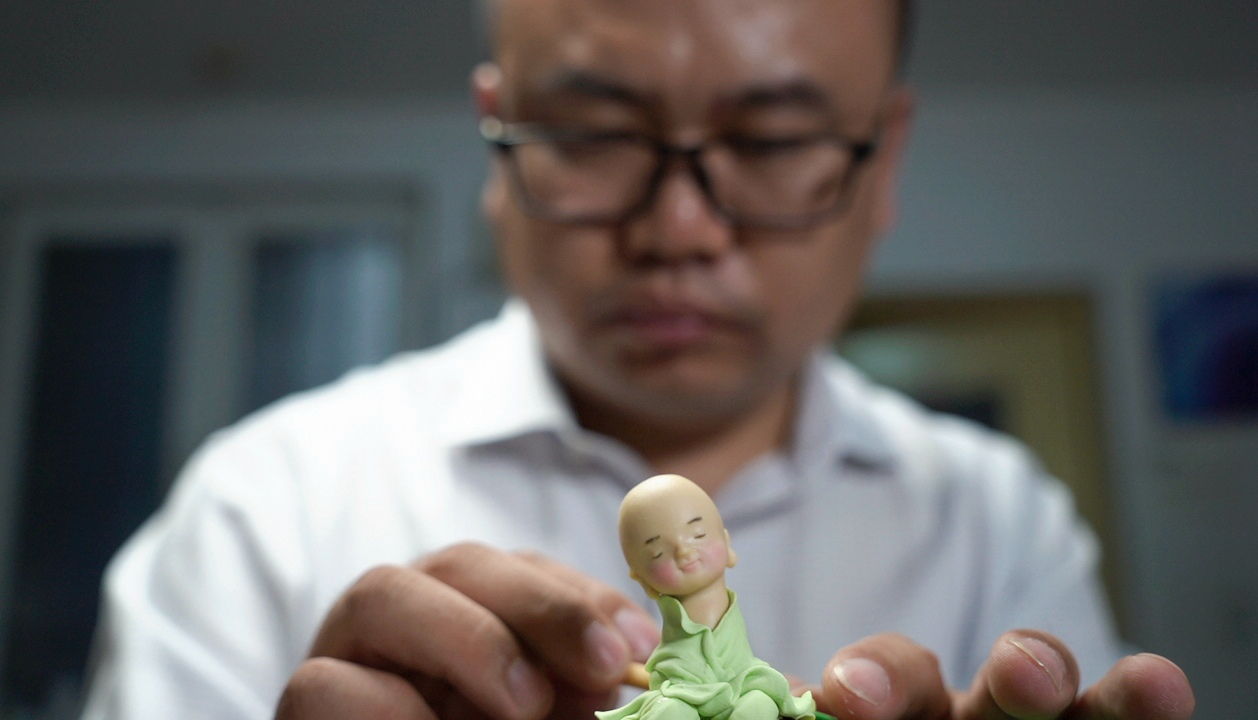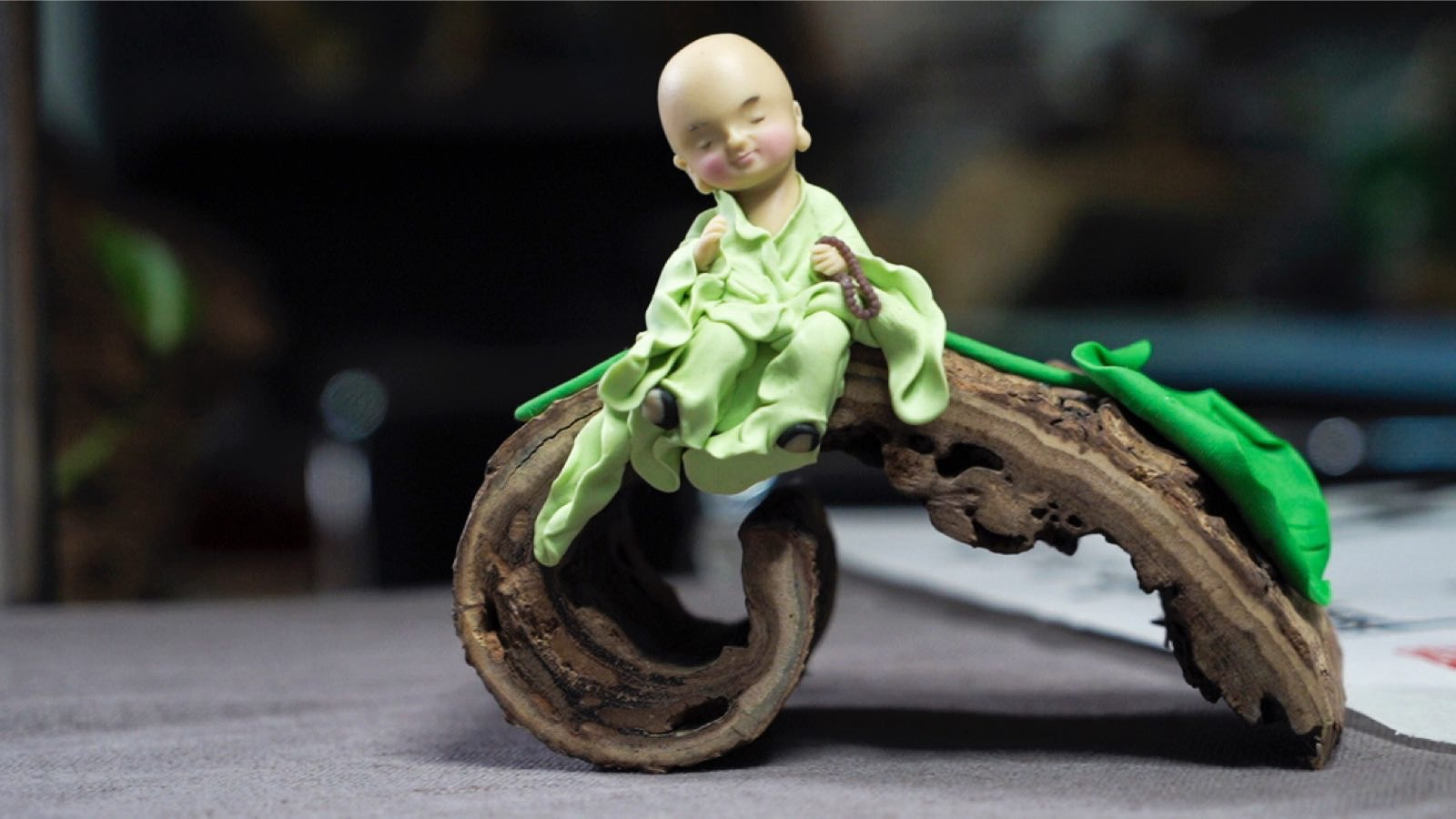
Culture
17:08, 28-Sep-2018
Dough Sculptures: A new stage for an ancient craft
Updated
17:02, 01-Oct-2018
By Ai Yan
03:01

After half an hour of kneading, pinching and trimming and these random dough lumps in different colors have been transformed into a little monk, sitting on a piece of wood, pondering with his eyes closed and a beaming smile on his face.
The craft is known as “dough sculpture”, an ancient folk art that used to be widely spread across north China. It can be traced back to the Han Dynasty (202 BC - 220), when dough sculptures were mainly used as offerings in ritual activities.
Hou Deqiang, who picked up the craft by chance about two decades ago, said that he wanted to learn a traditional craftsmanship skill.

Hou Deqiang is making a little monk using the dough. /CGTN Photo
Hou Deqiang is making a little monk using the dough. /CGTN Photo
“I read on a newspaper that many traditional crafts have been disappearing. It came across my mind that if I could learn about one kind and help to preserve it, it could be helpful,” said Hou.
But after studying and improving the craft for years, Hou said he now believes that dough sculptures could go beyond its original status and earn a wider stage, “which it deserves”.
How to make dough sculptures?
Surprisingly, there are quite a number of younger generations and even children learning the craft, according to Hou Deqiang.

Dough sculpture monk made by Hou Deqiang. /CGTN Photo
Dough sculpture monk made by Hou Deqiang. /CGTN Photo
“Most of them are like myself, who learn about it during their spare time, as a hobby,” he told CGTN. He added that many children learn the craft as a kind of handwork lesson. “The materials are also environmentally friendly,” said Hou.
The dough used for the sculptures are specially made. According to Hou, the dough lumps are a mixture of flour, glutinous rice flour, sugar, honey and glycerin. Honey and glutinous rice flour keep the sculptures from decomposing, while the glycerin prevents them from cracking.
“Make the mixture into a pie, and steam it for around 30 minutes. Then knead the dough repeatedly when it is still hot, until it becomes flexible and tender. Then drain the excess moisture,” said Hou Deqiang. “And then put it away and air-dry it for about a week, it could be used for making dough sculptures.”

The dough sculpture monks made by Hou Deqiang. /CGTN Photo
The dough sculpture monks made by Hou Deqiang. /CGTN Photo
Hou said that most of the sculptures today are not edible. In order to enable the dough lumps to create diversified shapes, most dough sculpture artists add inedible materials. The dough lumps also need to be dyed into different colors.
The process of making dough sculptures is very difficult to master, as it usually requires some basic knowledge of fine arts.
“In order to make the sculptures vivid, I often ask my students to observe the people in their daily lives, like what they wear and how their facial expressions are,” said Hou. “I didn't have any background in fine arts even when I started making dough sculptures.”
A wider stage for the ancient craft
Hou has been organizing classes, teaching people how to make dough sculptures, in order to make more people like the ancient craft. But he obviously has higher expectations than that.
He has been working on several new series of sculptures, one is the “Little Monk” series, and the other is the monsters from an ancient Chinese mythological classic “Shan Hai Jing” (The Classic of Mountains and Seas).

A dough sculpture of the monsters described in “Shan Hai Jing”. /CGTN Photo
A dough sculpture of the monsters described in “Shan Hai Jing”. /CGTN Photo
Many Chinese fairy tales were based on the monsters described in “Shan Hai Jing”, for instance, the “nine-headed phoenix”, the “nine-tailed fox” and the “Nüwa”, known as the mother goddess of Chinese mythology, who has a woman's face and a snake's body.
“An abundant array of fairy tale monster characters have recently appeared in many TV series and films, but when I started to read the books and wondered what the monsters look like, there were no illustrations at all,” said Hou.
“So it occurred to me to make the monsters out with dough sculptures, so that people in the future could get to know what the monsters look like,” he added. He is planning to make a total of 554 sculptures for the series.
Talking about his purpose in doing all this work, Hou said he never aims at a profit from making dough sculptures.
“I just believe that the dough sculptures should not be limited to just folk art. It could be combined with oil paintings, Chinese ancient paintings and stone carvings, as well as western sculptures, so as to become an art that would be able to attract international attention,” said Hou.
(Cameramen: Jiang Yuting, Chen Kairan; Film Editor: Jiang Yuting.
Head image: Qu Bo.
Deng Junfang and Zheng Songwu also contributed to the article.)

SITEMAP
Copyright © 2018 CGTN. Beijing ICP prepared NO.16065310-3
Copyright © 2018 CGTN. Beijing ICP prepared NO.16065310-3